Selecting From Post-and-Core Options to Ensure Anterior Esthetic Continuity
Robert G. Ritter, DMD
Providing patients with esthetic and functional restorations as part of a new smile design or restorative makeover presents clinicians with many challenges. These challenges include determining the appropriate type of restorations (eg, veneers versus full-coverage crowns), identifying the most esthetic and durable restorative materials (eg, pressed ceramics versus alumina or zirconium-based materials), and completing suitable preparation and placement protocol.
However, when the removal of the existing restorations and/or radiographic examination reveals previously placed endodontic posts and cores, the clinician may now be faced with providing renewed support to the root and the anticipated esthetic restoration using sound endodontic techniques, and must do so in an esthetic and clinically predictable manner.1,2 If the existing post-and-core foundation is adequate to support the proposed restoration and is fabricated from metal, then subopaquing will be required to prevent show-through of the metal once the new restoration is placed. If the existing post-and-core foundation must be replaced, the clinician is then faced with a decision regarding what type of post-and-core material to select to ensure long-term function and predictable esthetics.
CASE REPORT
A man presented after the veneer restoration on tooth No. 9 had fallen off (Figure 1). A thorough clinical examination and radiographic evaluation revealed a previously placed porcelain-fused-to-metal (PFM) crown on tooth No. 10, which had also undergone previous root canal therapy and the placement of a cast-metal endodontic post (Figures 2 and 3). The patient elected to undergo an esthetic smile design of his maxillary anterior teeth, including re-restoration of teeth Nos. 9 and 10. After thorough treatment planning, the patient’s existing restorations were removed, at which time the metal post in tooth No. 10 dislodged, necessitating replacement. Considering that esthetic all-ceramic restorations had been treatment planned for this patient, selecting the ideal post for this case became significant in several respects.
Posts and cores placed to support endodontically treated teeth not only directly affect the survival of the restorations, but they may also adversely affect their esthetic qualities if all-ceramicmaterials are prescribed.2,3 Post-and-core materials used to support all-ceramic restorations may influence the optical effects of the translucent material and the overall appearance of the smile.2,4
Without question, the design of the selected post and core, quantities of coronal dentin, preparation protocol, and cementation were important considerations for the success of the esthetic restorative treatment in this case.2 When clinicians are faced with choosing from among available post alternatives, which include traditional metal posts and those fabricated from quartz fiber, carbon-quartz fiber, zirconium dioxide, reinforced glass fiber, and reinforced epoxy resin,5-7 their decisions must be based on the characteristics and requirements of the specific case at hand. These may involve functional and esthetic considerations as well as variations in available coronal tooth structure and limitations of each post option.2
Studies have shown that an increased amount of coronal dentin significantly increases the fracture resistance of endodontically treated teeth when prefabricated posts are placed.8 Becauseroot fracture is one of the most seriouscomplications after the restoration of endodontically treated teeth, clinicians must consider the ferrule design incorporated into prefabricated posts when making their selections.8 The ferrule effect in endodontically treated teeth requiring posts and cores has been shown to greatly improve fracture resistance.9 However, the literature has stated that for the restoration of anterior endodontically treated teeth with a prefabricated post and composite core where at least 2 mm of remaining coronal dentin exists, a post may not be necessary.9
In the case illustrated here, because the smile design would be completed using esthetic all-ceramic restorations, the decision was made to place a glass-fiber post (Figure 4). Prefabricated fiber posts have demonstrated a flexible modulus of elasticity, which helps to distribute stresses at the radicular point, predictable adhesion with resins, and esthetic qualities.2,5,7,10 Fiber posts have been shown to reduce to a minimum the risk of root fractures to teeth restored with composite cores and all-ceramic restorations,5 and glass fiber posts in particular have been shown to induce a stress field similar to that of natural teeth.10 Additionally, contemporary metal-free post-and-core systems contribute to the esthetic restoration of endodontically treated teeth by facilitating light transmission and biocompatibility.11
The other option in this case could have been to place a cast-metal post and subopaque it to prevent it from showing through the final ceramic restorations. However, the use of traditional cast-metal posts when all-ceramic restorations are placed has resulted in poor esthetics because of the reflection and lack of light transmission.12 Subopaquing techniques are required in an attempt to improve the esthetics of these foundations. In terms of potential root fracture, cast-gold post and cores have been shown to produce the greatest stress concentration at the post-dentin interface.10 Additionally, when cast post and cores are placed, the greatest stresses have been observed at the lingual apex of the post, and stresses have been higher in metal-collared specimens.13
Conclusion
There are many quality post-and-core options available to clinicians today. When faced with the prospect of performing esthetic restorative dentistry that simultaneously requires endodontic support, the characteristics of the individual case will guide the clinician in choosing the most appropriate foundation for the restoration. Specifically, clinicians must take into account the patient’s overall endodontic and periodontal condition, root length, and histological structure of the devitalized tooth.9 It is this author’s experience that the esthetic continuity of smile designs can be ensured when esthetic glass-fiber posts are placed to support all-ceramic restorations (Figures 5 and 6).
References
1. Pitel ML, Hicks NL. Evolving technology in endodontic posts. Compend Contin Educ Dent. 2003;24(1):13-20.2. Milnar F. Esthetic restoration of the single endodontically treated anterior tooth. Compend Contin Educ Dent. 2004;25(1): 56-60.
3. Sorensen JA, Mito WT. Rationale and clinical technique for esthetic restoration of endodontically treated teeth with the Cosmopost and IPS Empress post system. Quintessence Dent Technol. 1998;12:81-90.
4. Morgano SM, Brackett SE. Foundation restorations in fixed prosthodontics: current knowledge and future needs. J Prosthet Dent. 1999;82(6):643-657.
5. Mannocci F, Ferrari M, Watson TF. Intermittent loading of teeth restored using quartz fiber, carbon-quartz fiber, and zirconium dioxide ceramic root canal posts. J Adhes Dent. 1999;1(2): 153-158.
6. Trushkowsky RD. Coronoradicular rehabilitation with a carbon-fiber post. Compend Contin Educ Dent. 1996; (20 suppl):S74-S79.
7. Ferrari M, Vichi A, Mannocci F, et al. Retrospective study of the clinical performance of fiber posts. Am J Dent. 2000; 13(spec no):9B-13B.
8. Pereira JR, de Ornelas F, Conti PC, et al. Effect of a crown ferrule on the fracture resistance of endodontically treated teeth restored with prefabricated posts. J Prosthet Dent. 2006;95(1):50-54.
9. Kutesa-Mutebi A, Osman YI. Effect of the ferrule on fracture resistance of teeth restored with prefabricated posts and composite cores. Afr Health Sci. 2004;4(2):131-135.
10. Pegoretti A, Fambri L, Zappini G, et al. Finite element analysis of a glass fibre reinforced composite endodontic post. Biomaterials. 2002;23(13): 2667-2668.
11. Quintas AF, Dinato JC, Bottino MA. Aesthetic posts and cores for metal-free restoration of endodontically treated teeth. Pract Periodontics Aesthet Dent. 2000;12(9): 875-884.
12. Michaelakis KX, Hirayama H, Sfolkos J, et al. Light transmission of posts and cores used for the anterior esthetic region. Int J Periodontics Restorative Dent. 2004;24(5):462-469.
13. Loney RW, Kotowicz WE, McDowell GC. Three-dimensional photoelastic stresanalysis of the ferrule effect in cast postand cores. J Prosthet Dent. 1990;63(5): 506-512.
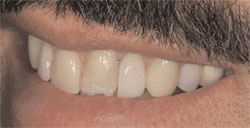 | 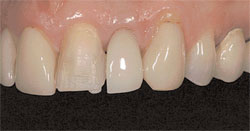 | |
| Figure 1 The patient presented after an old veneer restoration on tooth No. 9 had fallen off. An old PFM crown was also present on tooth No. 10. | Figure 2 Close-up view showing the leaking and failing restorations. | |
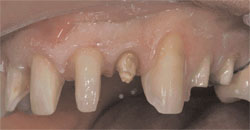 | 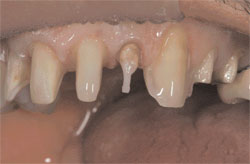 | |
| Figure 3 After radiographic examination and removal of the old restorations, the need for a new post-and-core build-up for tooth No. 10 was evident. | Figure 4 A glass-fiber post was adhesively bonded into the canal space of tooth No. 10. | |
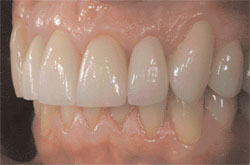 | 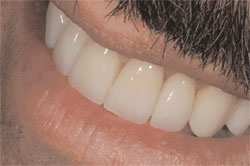 | |
| Figure 5 Close-up view of the final all-ceramic restorations. | Figure 6 View of the patient's final smile, demonstrating harmonious continuity of the allceramic esthetics. | |
| About the Author | ||
 Robert G. Ritter, DMD Robert G. Ritter, DMD Private Practice Palm Beach Gardens, Florida | ||



